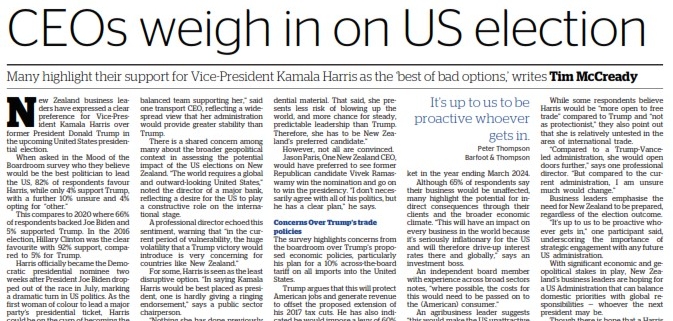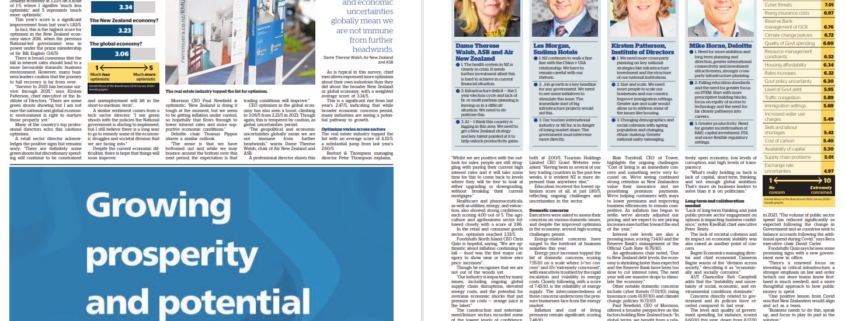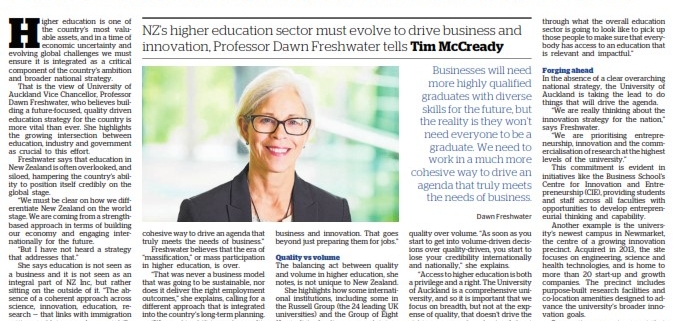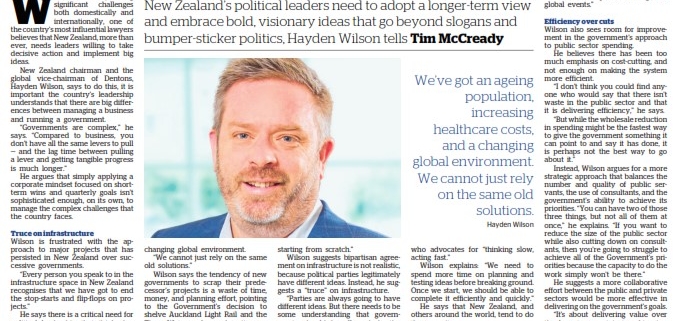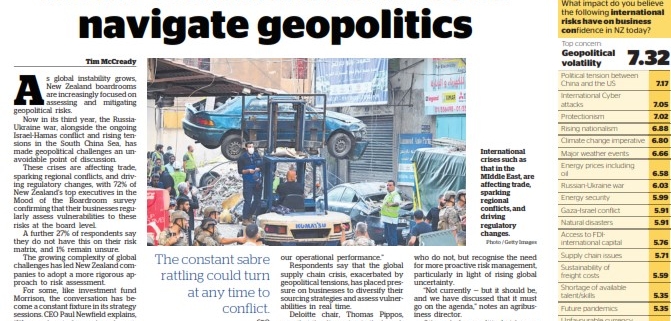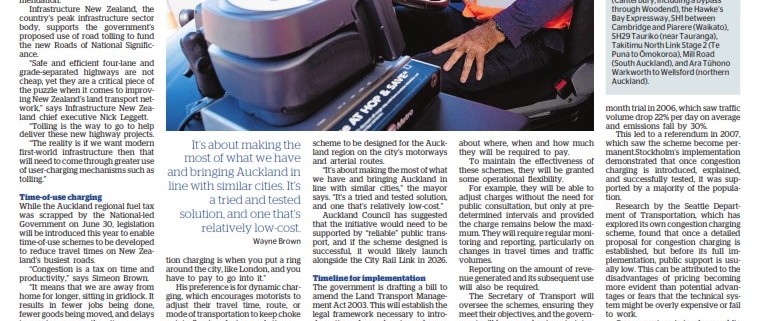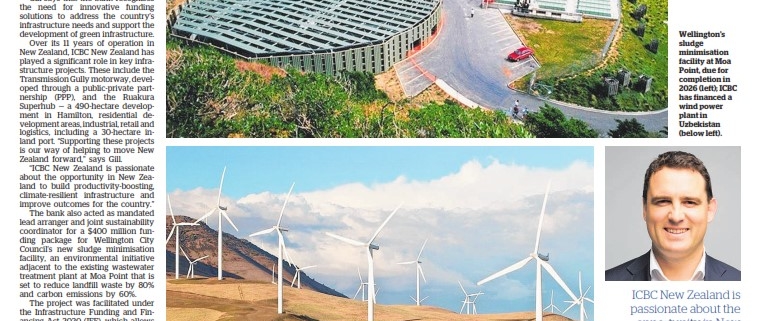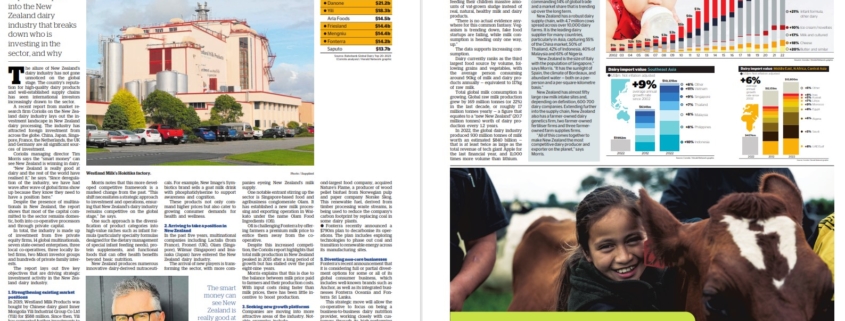The allure of New Zealand’s dairy industry has not gone unnoticed on the global stage. The country’s reputation for high-quality dairy products and well-established supply chains has seen international investors increasingly drawn to the sector.
A recent report from market research firm Coriolis on the New Zealand dairy industry lays out the investment landscape in New Zealand dairy processing. The industry has attracted foreign investment from across the globe. China, Japan, Singapore, France, the Netherlands, the UK and Germany are all significant sources of investment.
Coriolis managing director Tim Morris says the “smart money” can see New Zealand is winning in dairy.
“New Zealand is really good at dairy and the rest of the world have realised it,” he says. “Since deregulation of the industry, we have had wave after wave of global firms show up because they know they need to have a position here.”
Despite the presence of multinationals in New Zealand, the report shows that most of the capital committed to the sector remains domestic, both into co-operative processors and through private capital.
In total, the industry is made up of investment from five private equity firms, 14 global multinationals, seven state-owned enterprises, three local co-operatives, three locally listed firms, two Māori investor groups and hundreds of private family interests.
The report lays out five key objectives that are driving strategic investment activity in the New Zealand dairy industry.
1. Strengthening existing market positions
In 2019, Westland Milk Products was bought by Chinese dairy giant Inner Mongolia Yili Industrial Group Co Ltd (Yili) for $588 million. Since then, Yili has supported further investments to strengthen the West Coast dairy company’s position.
In 2021, Westland announced it would invest $40m to double its consumer butter manufacturing capacity. The following year it acquired Hamilton-based foodservice butter processor Canary Foods.
Last year, Westland announced a $70m investment to construct a new lactoferrin plant at its Hokitika facility. Supported by parent company Yili, this investment will more than treble production capacity of the multifunctional protein. Lactoferrin has growing international demand across a variety of nutritional categories because of its reported health benefits.
Increased competition as more players enter the market is driving a shift higher up the value chain, with focus shifting to producing higher-margin, value-added products rather than just raw milk.
Morris notes that this more developed competitive framework is a marked change from the past. “This shift necessitates a strategic approach to investment and operations, ensuring that New Zealand’s dairy industry remains competitive on the global stage,” he says.
One such approach is the diversification of product categories into high-value niches such as infant formula (particularly specialty formulas designed for the dietary management of special infant feeding needs), protein supplements, and functional foods that can offer health benefits beyond basic nutrition.
New Zealand produces numerous innovative dairy-derived nutraceuticals. For example, New Image’s Symbiotics brand sells a goat milk drink with phosphatidylserine to support awareness and cognition.
These products not only command higher prices but also cater to growing consumer demands for health and wellness.
2. Arriving to take a position in New Zealand
In the past five years, multinational companies including Lactalis (from France), Froneri (UK), Olam (Singapore), Wilmar (Singapore) and Imanaka (Japan) have entered the New Zealand dairy industry.
The arrival of new players is transforming the sector, with more companies eyeing New Zealand’s milk supply.
One notable entrant stirring up the sector is Singapore-based food and agribusiness conglomerate Olam. It has established a new milk processing and exporting operation in Waikato under the name Olam Food Ingredients (Ofi).
Ofi is challenging Fonterra by offering farmers a premium milk price to entice them away from the co-operative.
Despite this increased competition, the Coriolis report highlights that total milk production in New Zealand peaked in 2015 after a long period of growth but has stalled over the past 8-9 years.
Morris explains that this is due to the balance between milk price paid to farmers and their production costs. With input costs rising faster than milk prices, there has been little incentive to boost production.
3. Seeking new growth platforms
Companies are moving into more attractive areas of the industry. Notable examples include:
Nestle Health Science, a global leader in nutrition, bought The Better Health Company in 2022, which included the supplements brand GO Healthy. Nestle Health Science described the acquisition as a strategic fit, enhancing its global portfolio of active lifestyle and health and wellness brands.
In 2020, New Zealand’s largest seafood company, Sanford, acquired a 50% stake in Two Islands. This merger leverages marine collagen, a by-product of Sanford’s certified sustainable hoki fishery, which is used in Two Islands’ range of beauty and wellbeing products.
4. Investing in increasing sustainability
Companies are investing in sustainability to align with changing customer, consumer and government requirements. Examples include:
Talley’s Group, New Zealand’s second-largest food company, acquired Nature’s Flame, a producer of wood pellet biofuel from Norwegian pulp and paper company Norske Skog. This renewable fuel, derived from timber processing waste streams, is being used to reduce the company’s carbon footprint by replacing coal in some dairy plants.
Fonterra recently announced a $790m plan to decarbonise its operations. The plan includes exploring technologies to phase out coal and transition to renewable energy across its manufacturing sites.
5. Divesting non-core businesses
Fonterra’s recent announcement that it is considering full or partial divestment options for some or all of its global consumer business, which includes well-known brands such as Anchor, as well as its integrated businesses Fonterra Oceania and Fonterra Sri Lanka.
This strategic move will allow the co-operative to focus on being a business-to-business dairy nutrition provider, working closely with customers through its high-performing ingredients and foodservice channels.
Fonterra says this refocus will strengthen its role in the dairy nutrition value chain, leveraging its strength in producing world-class, innovative ingredients for customers to take to consumers.
Another example of divestment was seen from Synlait, which last year announced its plans to sell off its household dairy brands Dairyworks and Talbot Forest Cheese in order to pay down debt. At the time, Synlait said this move would allow it to focus solely on its value-added, advanced nutrition and foodservice businesses.
6. Dairy remains an attractive investment
Morris is clear that the dairy market will remain an attractive investment into the future and doesn’t mince his words on the potential for “alternative milk” to supersede the industry.
“It is easy for people to convince themselves that because their daughter is vegan, or friends of theirs have started to drink oat milk, that everywhere on Earth is suddenly just like them.
“It’s just not true.
“Silicon Valley venture capitalists will try to convince you that we are at peak cow or peak milk or some other such nonsense. Any minute now, mothers everywhere will be feeding their children massive amounts of vat-grown sludge instead of real, natural, healthy milk and dairy products.
“There is no actual evidence anywhere for this common fantasy. Veganism is trending down, fake food start-ups are failing, while milk consumption is heading only one way, up.”
The data supports increasing consumption.
Dairy currently ranks as the third-largest food source by volume, following grains and vegetables, with the average person consuming around 90kg of milk and dairy products annually — equivalent to 117kg of raw milk.
Total global milk consumption is growing. Global raw milk production grew by 169 million tonnes (or 22%) in the last decade, or roughly 17 million tonnes yearly — a figure that equates to a “new New Zealand” (20.7 million tonnes) worth of dairy production every 1.2 years.
In 2022, the global dairy industry produced 930 million tonnes of milk worth an estimated $840 billion — that is at least twice as large as the total revenue of tech giant Apple for the last financial year, and 11,000 times more volume than lithium.
Sunlight of Spain, climate of Bordeaux, and water …
New Zealand is the world’s largest dairy exporter by value, commanding 14% of global trade and a market share that is trending up over the long term.
New Zealand has a robust dairy supply chain, with 4.7 million cows spread across over 10,000 dairy farms. It is the leading dairy supplier for many countries, particularly in Asia, capturing 55% of the China market, 50% of Thailand, 42% of Indonesia, 40% of Malaysia and 61% of Nigeria.
“New Zealand is the size of Italy with the population of Singapore,” says Morris. “It has the sunlight of Spain, the climate of Bordeaux, and abundant water — both on a per-person and a per-square-kilometre basis.”
New Zealand has almost 50 large raw milk intake sites and, depending on definition, 600-700 dairy companies. Extending further into the supply chain, New Zealand also has a farmer-owned dairy genetics firm, two farmer-owned fertiliser firms and three farmer-owned farm supplies firms.
“All of this comes together to make New Zealand the most competitive dairy producer and exporter on the planet,” says Morris.


